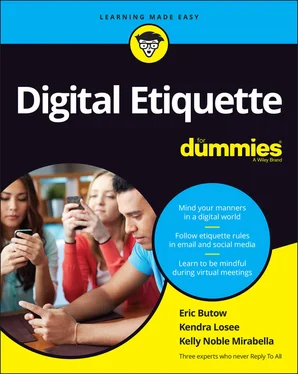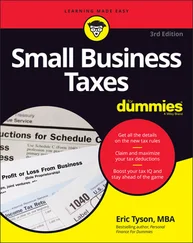Eric Butow - Digital Etiquette For Dummies
Здесь есть возможность читать онлайн «Eric Butow - Digital Etiquette For Dummies» — ознакомительный отрывок электронной книги совершенно бесплатно, а после прочтения отрывка купить полную версию. В некоторых случаях можно слушать аудио, скачать через торрент в формате fb2 и присутствует краткое содержание. Жанр: unrecognised, на английском языке. Описание произведения, (предисловие) а так же отзывы посетителей доступны на портале библиотеки ЛибКат.
- Название:Digital Etiquette For Dummies
- Автор:
- Жанр:
- Год:неизвестен
- ISBN:нет данных
- Рейтинг книги:5 / 5. Голосов: 1
-
Избранное:Добавить в избранное
- Отзывы:
-
Ваша оценка:
- 100
- 1
- 2
- 3
- 4
- 5
Digital Etiquette For Dummies: краткое содержание, описание и аннотация
Предлагаем к чтению аннотацию, описание, краткое содержание или предисловие (зависит от того, что написал сам автор книги «Digital Etiquette For Dummies»). Если вы не нашли необходимую информацию о книге — напишите в комментариях, мы постараемся отыскать её.
Digital Etiquette For Dummies,
Digital Etiquette For Dummies
Digital Etiquette For Dummies — читать онлайн ознакомительный отрывок
Ниже представлен текст книги, разбитый по страницам. Система сохранения места последней прочитанной страницы, позволяет с удобством читать онлайн бесплатно книгу «Digital Etiquette For Dummies», без необходимости каждый раз заново искать на чём Вы остановились. Поставьте закладку, и сможете в любой момент перейти на страницу, на которой закончили чтение.
Интервал:
Закладка:
Seeing what’s needed
All these terms and conditions comprise a contract in which the owner of the product, service, and/or website states the conditions of use for the product or service. For example, this document lists rules that users must follow when interacting with one another on a social media site and specifies what will happen if those rules aren’t followed.
In your terms and conditions, you need to ensure that you have liability clauses and disclaimers, such as the fact that a website will likely go down from time to time. This is because a vital reason to have a Terms and Conditions document, no matter what you call it, is to cover your backside. If one or more users bring court action against you, your Terms and Conditions document is your first line of defense.
Comparing privacy policies with terms and conditions
Why do you need a privacy policy as well as a Terms and Conditions document? Aren’t they the same thing?
It’s true that a privacy policy and Terms and Conditions are legally binding documents. But that’s where their commonality ends.
Privacy policies are legally required in most countries. They not only protect your users but also declare your compliance with the privacy laws in those countries and, in some cases, states.
Terms and conditions, on the other hand, are designed to protect you and your business. Business owners can set their rules about how their website, service, and/or product is used — within laws set by the country and perhaps the state where you do business.
Banning spam from your company toolset
Speaking of company policies, the growth of the Internet and email brought with them the unwanted email phenomenon of spam — the company practice of sending unwanted email messages to large numbers of people. The practice (in one form or another) dates all the way back to 1978, though the word spam wasn’t used to describe the practice until 1993 ( www.socketlabs.com/blog/know-history-spam ).
The practice became so widespread and raised so many alarms by the early 2000s that the United States Congress passed the Controlling the Assault of Non-Solicited Pornography And Marketing Act in 2003. The act is better known by its acronym: CAN-SPAM. The CAN-SPAM Act established the first national standards for sending commercial email.
 You can tell computing spam from the lunch meat because Hormel, the food company, refers to the lunch meat as SPAM. And the term is a portmanteau — a combination of the words sp iced h am. There’s no telling how much attention, good or bad, spam producer Hormel has received from the word being used constantly in online communication.
You can tell computing spam from the lunch meat because Hormel, the food company, refers to the lunch meat as SPAM. And the term is a portmanteau — a combination of the words sp iced h am. There’s no telling how much attention, good or bad, spam producer Hormel has received from the word being used constantly in online communication.
If your company is already sending out email messages as part of its marketing strategy — or is planning to — you need to be aware of the seven guidelines underlying the CAN-SPAM Act. That's because, when it comes to taking a closer look at the “ingredients” of the CAN-SPAM Act, seven is the lucky number. Here’s a breakdown of what this law means — in seven easy bullet points — for your company’s email marketing strategy:
Don’t use a misleading header for your email messages. That is, make sure the intended recipient is the one who is receiving the message and that the person in the From box in the message is the person from your company.
Make sure the subject line matches the message content. The subject line should always give the reader a good idea of what’s in the message.
Address what the message is about up front. That is, if your message is an ad, tell them it’s an ad. Don’t be misleading. Your recipients may reward your honesty.
Include your company’s current physical postal address and your phone number. Your recipients want to know that you’re an actual business. (This is also required by law in Canada, and we’ll talk about Canadian requirements later in this chapter.)
Give your recipients the option to unsubscribe from future emails. And make sure that the opt-out language is clear and easily found because, if people can’t find it, your company or the authorities may start to field complaints that will distract you and your team.
Be sure to unsubscribe people. The CAN-SPAM Act requires that you must process unsubscribe requests for at least 30 days after you send the email, and every unsubscribe request must be processed within 10 business days.
Don’t charge a fee or ask for any additional personal information to have them unsubscribe. If your company uses an automated email marketing service such as Mailchimp, you can set up Mailchimp to have people fill out a short survey about why they’re leaving.
 Don’t have your company send messages by way of a Gmail account. Gmail addresses show recipients a) that your business has no website or b) that your business has no money to pay for a unique website domain that comes with free email addresses or c) that you don’t want to make the effort to create your own accounts. One or some combination of these excuses will lead to the same destination: It looks like your email and your business aren’t legitimate. And it doesn’t help that professional spammers use Gmail accounts because they’re free.
Don’t have your company send messages by way of a Gmail account. Gmail addresses show recipients a) that your business has no website or b) that your business has no money to pay for a unique website domain that comes with free email addresses or c) that you don’t want to make the effort to create your own accounts. One or some combination of these excuses will lead to the same destination: It looks like your email and your business aren’t legitimate. And it doesn’t help that professional spammers use Gmail accounts because they’re free.
 You may have heard this one a million times already: Always monitor what people are saying and reading about your company by creating a Google Alert with your company name, having someone review your social media, and by checking websites where your company may be mentioned. (This might be a good task for a marketing intern.) Your company is responsible for complying with the CAN-SPAM Act, even if you outsource your marketing to a separate company. Keeping track of who’s-saying-what can not only help improve your marketing but also put out any email marketing fires.
You may have heard this one a million times already: Always monitor what people are saying and reading about your company by creating a Google Alert with your company name, having someone review your social media, and by checking websites where your company may be mentioned. (This might be a good task for a marketing intern.) Your company is responsible for complying with the CAN-SPAM Act, even if you outsource your marketing to a separate company. Keeping track of who’s-saying-what can not only help improve your marketing but also put out any email marketing fires.
 If you want to find more guidance about CAN-SPAM requirements and see answers to frequently asked questions, go to the source: the Federal Trade Commission (FTC). You can visit its CAN-SPAM compliance guide web page (see Figure 2-3) on the FTC website at
If you want to find more guidance about CAN-SPAM requirements and see answers to frequently asked questions, go to the source: the Federal Trade Commission (FTC). You can visit its CAN-SPAM compliance guide web page (see Figure 2-3) on the FTC website at www.ftc.gov/tips-advice/business-center/guidance/can-spam-act-compliance-guide-business .

FIGURE 2-3:The CAN-SPAM Act Compliance Guide for Business web page.
Conducting your business online
If you’re a glutton for punishment and make your way through all the clauses and subclauses of the CAN-SPAM Act, you may end up thinking that there's no way you can end up doing any business online. The good news is that the FTC has anticipated your doubt and preemptively answers a lot of f requently a sked q uestions — you know, FAQs. We’ve summarized those questions and answers for you in the following list:
The three information types: The CAN-SPAM Act applies depending on the primary purpose of the email message. The FTC has three different types of information: Commercial content, which advertises or promotes a commercial product, commercial service, or website that’s operated for a commercial product or service Transactional or relationship content, which is content about a transaction you’ve already agreed to with the other party, as well as updates sent to a customer about an ongoing transaction Other content, which doesn’t fit into one of the other two categoriesIf you’re guessing that your email falls into the commercial category, then pass Go and collect your 200 dollars — the email is governed by the CAN-SPAM Act.
Читать дальшеИнтервал:
Закладка:
Похожие книги на «Digital Etiquette For Dummies»
Представляем Вашему вниманию похожие книги на «Digital Etiquette For Dummies» списком для выбора. Мы отобрали схожую по названию и смыслу литературу в надежде предоставить читателям больше вариантов отыскать новые, интересные, ещё непрочитанные произведения.
Обсуждение, отзывы о книге «Digital Etiquette For Dummies» и просто собственные мнения читателей. Оставьте ваши комментарии, напишите, что Вы думаете о произведении, его смысле или главных героях. Укажите что конкретно понравилось, а что нет, и почему Вы так считаете.












